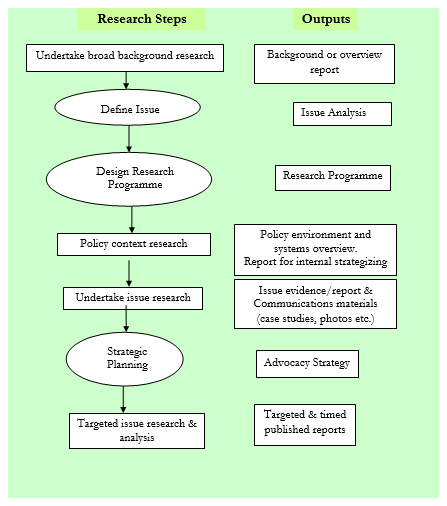
Steps in the Research Process
Research Methods and Sources
Organizational Library
Scanning
Meetings and Consultations
Steps in the Research Process
There may also be additional research needed for strategic analysis
Research Methods and Sources
The first stages of research will include:
- Studies and literature reviews
- Academic or scientific research
- Gathering facts, figures and statistics
After this stage, there are various other research methods available:
- Depth interviews
- Consultations/focus groups/working groups
- Opinion polls
- Surveys and questionnaires
- Computer conferences
- Field visits and investigations
- Case studies
- Pilot projects
There are now many useful sources for research, and using a wide range will add depth, context and interest to your work. Do not restrict your research to the Internet and your local library (however convenient this may seem)! Remember that there are many other organizations out there collecting information (including international organizations, governments, universities and other NGOs) – and many would be only too willing to share this with you. Think of all the bodies with a professional interest in your issue, and find out what research they already have available or are working on.
After desk research, initial fact-finding meetings (e.g. with civil servants working for key policy makers) can help to ascertain key motivations, possibilities, and barriers – which can then be specifically targeted and dealt with in subsequent research.
Avoid going into too much depth before you have made an informed assessment of what is feasible (so as not to waste time).
Also, do not consider your research over as soon as your report has been finished. It pays dividends to keep abreast of your issue throughout your advocacy campaign. If you have the resources, it is helpful to order any relevant publications (such as trade or issue journals). Many organizations organize a press cutting service – where they monitor the media on their issue and send copies of any relevant articles around to interested staff. This helps to update those involved on any changes in policy or public opinion (which can be factored into their advocacy work).
Internet
An enormous amount of information can be found on the Internet these days. Using a search engine, such as Google (see Web Site reference below), you simply enter key words to define your search. If you are inundated with results, then make your keywords more restrictive/accurate. Conversely, if you obtain no results, simply widen your keyword category. When using information found on a Web site in a published document, this should be referenced using the Web Site URL and the date accessed.
|
Tip Remember legitimacy and credibility are necessary for policy influence Double-check and reference your sources. Only use recognized and credible sources (intergovernmental or governmental organizations are excellent sources). A useful ploy is to use your targets’ or your opponents’ information where possible (as they cannot contest this!). Be skeptical when analyzing and citing statistics, as what is reported to government and intergovernmental statisticians and what is actually happening on the ground may be - and often is - very different. Where possible try to verify the statistics you cite by finding data from more than one source. |
Organizational Library
Some animal welfare organizations keep their own reference library. This can be extremely helpful, as it provides quick access to selected books, and relevant reports and other publications. Even smaller organizations can start useful book collections – it is surprising how these build up over time.
Scanning
The broadest form of information gathering is ‘scanning’. It can include all the factual material to be seen on television, read in newspapers and periodicals. To scan effectively the following is needed:
- To identify and order relevant publications
- To ensure a range of publications in order to understand different viewpoints (e.g. different political viewpoints, trade as well as animal welfare etc.)
- A press cutting service/person
- A circulation/notification system
Scanning should be a continuous activity for advocacy organizations.
Need for Focus
As well as different modes of scanning, there are different levels of information gathering ranging from the broader political environment to that related directly to the campaign issue. Tips for advocacy research:
- Target within agreed campaign strategy
- Start wide; decide focus; narrow search
Caution!
In practice any investigation can only use a small fraction of the available information. Warning: information is boundless; scanning can be costly. And don’t forget copyright law, and need to give sources!
Research Support
One good tip is that you may be able to use University students (e.g. veterinary students) to help you with your research. Some may do this free-of-charge, if they can use the results towards their studies/research. This can then also involve the University staff/lecturers, which has the added benefit of adding to their understanding and support.
Meetings and Consultations
Once the available information has been collected, it is helpful to arrange background meetings and fact-finding consultations. These could include potential targets, partners, competitors or any other stakeholders involved in the issue or the fight against it e.g. government, industry, academics/scientists, cultural/religious bodies, professional bodies such as vets, lawyers, biologists etc., and other animal welfare societies/NGOs.
This may lead to a greater understanding of: areas to target and/or avoid; potential strengths and weaknesses; driving factors of the problem; relevant political and legislative factors; potential collaborators and competitors etc.



